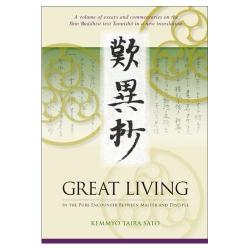Great Living – In the Pure Encounter Between Master and Disciple

By Kemmyo Taira Sato, American Buddhist Study Center Press, 2010, 206 pages, US$25.95, ISBN-13: 978-0976459477
Review by Andrew Webb
Great Living – In the Pure Encounter Between Master and Disciple – is a volume of essays and commentaries on the Japanese spiritual classic, the Tannisho (歎異抄), in a new English language translation for a western audience. The Tannisho is the most famous text of the Japanese Jodo Shinshu [浄土真宗] – True Pure Land School or ‘Shin Buddhist’ tradition and as such has seen several translations into English over the last 80 years. With Rev. Professor Sato’s translation and commentary, however, we have a meticulously detailed examination and profound appreciation of the text from the perspective of the living encounter between teacher and student that lies at the heart of the Shin Buddhist faith.
The Tannisho (A Record of Lament over Divergence) itself is a collection of the sayings of Shinran [親鸞] Shonin (1173-1262) compiled by his close disciple Yuien. It is a brief work consisting of eighteen chapters divided into two parts, each with a short preface, followed by a postscript together with an historical endnote. Rev. Sato remarks at the beginning of the work, “The Tannisho is neither an academic work nor a mere historical document; it is, rather, the record of a living encounter that took place between master and disciple in medieval Japan”. ‘Encounter’ is a word that occupies a very special place in this work and has a completely different emphasis from how we may ordinarily understand the term. As Rev. Sato states at the beginning of his commentary,
“Encounter can serve as the very source of spiritual light in our lives, provided it is realised purely….We arrive at this newfound situation through the spiritual light of self-awakening that breaks down the barriers that we have thrown up between ourselves and others. In the Tannisho we can see this taking place in the genuine encounter between Shinran Shonin and Yuien.”
The ‘living encounters’ reflected in the work are several. There are the two formative encounters between Shinran Shonin and his own master Honen [法然] Shonin and between Shinran Shonin and his disciples including of course Yuien. Next from the inner dimension of Shinran Shonin’s own religious experiences there are a further two encounters, namely Shinran Shonin’s encounter with the nature of his true self as an ordinary being burdened with “bad karma” and his encounter with Amida Buddha [阿弥陀仏] who saves all beings without any form of discrimination. These are the two inseparable aspects of the Shin Buddhist faith-experience which Shinran Shonin received through his own encounter with his master Honen Shonin and which Yuien wished to transmit through the Tannisho to later generations.
It is through the lens of spiritual encounter that Rev. Sato focuses on the Tannisho not as an ancient academic work but as a vivid and dynamic record of a living spirituality concerned with the realities of everyday life. The Tannisho was originally compiled to make people aware of the many challenges that confront Shin Buddhist followers and to show them the way to go beyond these problems. In his commentary Rev. Sato brings out the relevance of these problems to the modern audience and also shows us the way to go beyond them through faith in Amida Buddha.
Rev. Sato first arrived in London from his parent temple, Shogyoji [正行寺], in 1993 and since then, with his wife Hiroko, has tirelessly been involved in the creation of a Shin Buddhist centre called Three Wheels. A major part of his activities has been in translating and commenting on core Shin Buddhist texts like the Tannisho. Originally the essays which make up this work were given as talks at the London Buddhist Society. However, these were much more than just talks given to an audience, they were also dialogues with those who came to listen and to ask questions of him. It is this open spirit of dialogue which shines through the entire book and make it such a joy and treasure to read.

